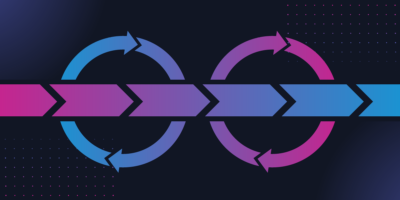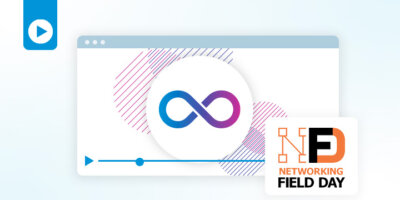As network teams face increasing amounts of network changes and configuration management operations, there’s a rising emphasis on NetDevOps — where NetOps teams take networking best practices and integrate them with key DevOps tools and methods. In addition, network teams are looking to incorporate more network infrastructure testing into CI/CD pipelines, further contributing to the shift. Today, both technology and mindsets have aligned to the point that we can overcome the siloed model between NetOps and DevOps and build a new, integrated approach: NetDevOps.
NetDevOps represents a cultural shift. It centers on leveraging network programmability to integrate with rapid DevOps cycles to deliver infrastructure changes rapidly and securely. To achieve this shift, teams need to move away from manual processes. They will automate configuration changes and orchestration using APIs, build automated instrumentation and monitoring updates, and program intent and policy into the network, enhancing collaboration between network and development teams.
The Shift Left
How do teams get started with NetDevOps? We can look to the “shift left” that’s happening in other areas of technology infrastructure, where concerns like testing and business goals are brought into the development cycle earlier, allowing for more dynamic, faster deployments and enabling greater automation reach.
One example of this shift involves networking teams participating in DevOps processes by creating automations that assist in deploying network infrastructure for applications (now a manual process) and allowing for DevOps teams to utilize those automations within their tools and processes. With this approach, applications can be developed with features that ask the network for different resources.
As this new emphasis on network and development teams working closely together continues to take hold, the market of innovative solutions in the NetDevOps sector will continue to mature as well. As a recent GigaOm report states, “we anticipate rapid evolution in the next 18 to 36 months.”
NetDevOps can transform the ways an organization’s infrastructure is tested and deployed, but to reap the full benefits, organizations will need to commit to a cultural, as well as a process shift.
How to Bring DevOps Culture to NetOps
Traditionally, network operations have been seen as closed silos where everything moved slowly and with little visibility from the applications or systems engineering side.
But including network engineering teams and their knowledge earlier in the development process will help the development team understand and optimize architectures, enforce consistent IP address best practices, and consolidate more metrics to enrich the organization’s observability system. It also allows the network team to provide guidance on how to make network changes correctly and safely — both of which are critical for building and scaling trusted automations.
Key Steps
- Adopt a Culture-First Approach: Define why network and development collaboration is important and work to break down traditional silos. Build ways for team members to learn from each other across departments and disciplines.
- Sharpen Skill Sets: Expand the knowledge and resources network engineers can
- Embrace Automation: Manage your network fluidly across an expanding tech stack.
Learning Curve: Network Engineer to Network Automation Engineer
For NetDevOps to be successful, it’s important both for developers to learn networking fundamentals, and for network engineers to adopt APIs in the same ways they’ve adopted CLIs to configure network devices and services. That way, organizations will be equipped to translate existing network processes into API-first automations.
The good news is that nobody’s trying to tell you to turn all your network engineers into software developers. Or at least, they shouldn’t be. One of the key reasons NetDevOps is more possible today than ever before is the amount of automation and integration support that exists out there in today’s API-first ecosystem. Network engineers can leverage tooling that exists and practices that have already been developed on the DevOps side to really accelerate the learning curve and start seeing progress with automation right away.
DevOps concepts like pipelines, CI/CD, common standards, and automation are tried and tested for success in software development. Treating network infrastructure as code involves adopting these proven tools and practices. Additionally, networking is a fundamental and necessary pillar for systems and application deployment. Every decision about networking will have consequences in the delivery of IT services.
Organizations must continue to adopt DevOps culture for networking by bringing the best DevOps practices to network operations and adopting network understanding into other teams. Evolving skill sets to achieve higher impact, understanding networking principles, and adopting an automation mindset and skills will increase your teams’ impact and bring them into the world of NetDevOps.
How Itential Helps Teams Adopt NetDevOps
The primary way Itential helps enable NetDevOps is with our robust integration capabilities. Itential is API-first to fit into the modern networking and IT technology ecosystem. That means integration with all your systems is easy, so you can automate seamlessly between any network and IT systems and across all networking domains.
In addition, Itential allows network teams to access the reusability that’s become common practice in the DevOps world. All automation assets like data transformations, auto-generated API adapters, and more that your automation team creates are then added to a library to be reused in other automations. Over time, the network automation team becomes more and more efficient by turning work performed into value-generating assets, just like a DevOps team today.
Itential also provides robust bi-directional integration with CI/CD pipelines to enhance and speed up collaboration between networking and development teams. Network teams can include steps in their automated workflows that push certain tasks to a pipeline, allowing network engineers to leverage robust unit testing and other pipeline-powered capabilities that go far beyond what they could do on their own. And on the flip side, network automations can also be published for consumption by pipelines as end users, allowing development teams to request network change processes for self-service and see the change executed with no manual intervention from the networking team.
Interested in learning more about adopting NetDevOps with Itential? You can watch this webinar on the technical, cultural, and organization requirements to adopt NetDevOps with Itential’s CTO, Chris Wade, and Futuriom Founder & Chief Analyst Scott Raynovich. In the mood to read instead? You can also check it out in white paper form here.





